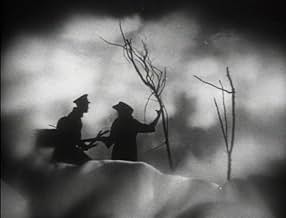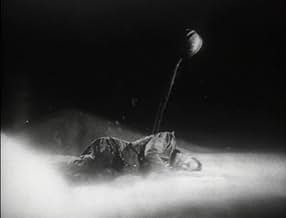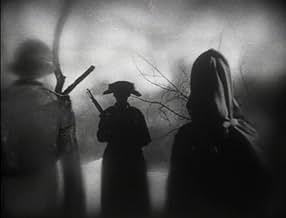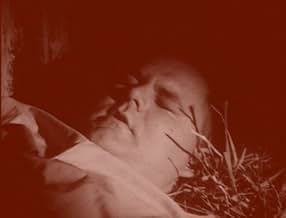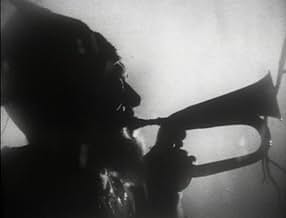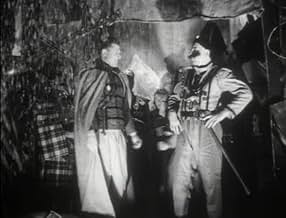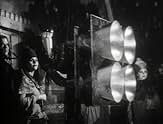Adicionar um enredo no seu idiomaAn amnesiac soldier, seeking his lost love, arrives in Archangel in northern Russia to help the townsfolk in their fight against the Bolsheviks, all quite unaware that the Great War ended th... Ler tudoAn amnesiac soldier, seeking his lost love, arrives in Archangel in northern Russia to help the townsfolk in their fight against the Bolsheviks, all quite unaware that the Great War ended three months ago.An amnesiac soldier, seeking his lost love, arrives in Archangel in northern Russia to help the townsfolk in their fight against the Bolsheviks, all quite unaware that the Great War ended three months ago.
- Direção
- Roteiristas
- Artistas
- Prêmios
- 1 vitória no total
- Stage Kaiser Wilhelm II
- (as Snyder)
- Baby
- (as Graham Blicq)
- Direção
- Roteiristas
- Elenco e equipe completos
- Produção, bilheteria e muito mais no IMDbPro
Avaliações em destaque
Filming entirely indoors with homemade props and costumes, director Guy Maddin has created a very strange and intense movie. Cribbing heavily from the look and atmosphere of German expressionist cinema, Maddin goes much further in exploring some very human issues: loss, love, memory and redemption. He also examines patriotism and by stylistically depicting the horrors of trench warfare he delivers a pacifist message that reminds me of movies like Grande Illusion and All Quiet on the Western Front. The ultimate power of this movie, however, lies in the sense of alienation we see among the characters. They are not only unable to love each other, they are barely able to communicate. In fact, under the cloud of forgetfulness that is a major theme in this movie, the characters are often not even capable of recognizing one another at all!
I'm really beginning a deep appreciation of this man's visual soul. While this project didn't change my life, it demonstrated the power to do so, like a strutting policeman among weak minds.
What I like about his mind is how he seats the thing first in the soul, then in the cinematic vocabulary instead of the usual path which values character, motivations, narrative clarity. What he's done here is revisit Eisenstein. I don't suppose many filmgoers have much truck for a Russian silent filmmaker who was primarily occupied in Soviet propaganda. He developed some important ideas about how a scene (never a movie only a scene) can be constructed from visual fragments what it means to "see."
His particular solutions aren't popular today, and the whole idea of slicing the eye has been appropriated to the service of now-conventional values of storytelling and the cult of celebrity some few jokes and even fewer emotions destinations.
Eisenstein's idea is based on the notion of readable cells of retinal comprehension, more or less of the same size which when combined give an impression. The more discrete the components in presentation the more comprehensible the assembly, what he called the collage.
What Maddin does here is make a metaEisenstein. The story is set in Russia and populated by international warriors, all of whom have only a groggy notion of why they are there. Our hero, like Maddin, is Canadian. It is essentially a silent movie. There is a parallel movie that is a talkie, into which this silent, main piece is embedded.
Within the silent movie is a sort of "movie within," exactly as abstract from the silent portion as the silent portion is to the talkie portion and thence not to our world (as is the usual case with folding) but to the world of normal movies.
That "movie within" is the "illumination" a set of stage tableaux depicting famous battles. If you experience nothing but these or rather if you skate over all the surrounding context and focus only on these you will be rewarded. There's so much reference there.
The overall theme of the thing is the hard boundary of memory, where the continuity of knowing begins and ends. In the story, this exhibits as amnesia plus a sort of quantum identity shifts of women, who else? That's good, its valuable. But the interesting thing is how this is seated in the collage itself. Eisenstein's idea is that each cell, each image, of the collage needs to have some reference to the others. The art is in the nature of that reference.
Maddin makes that reference sit on the cells. In his case they are not bubbles in transparent foam that light can shine through. Instead they are stones, smooth stones with hard impenetrable skins that only know themselves and keep forgetting those they are nestled against. So they forget who they are.
Ted's Evaluation -- 3 of 3: Worth watching.
This film is both gruesome and powerful, it makes a statement about dealing with love and loss, while also entertaining us with its wacky plot and laugh out loud humor. I had a ball watching this bizarre, tragicomic tale, mainly due to its fast paced nature and heavy surrealism. Those who seek an other wordly experience will likely adore this film, for I think it best captures Maddin's famously odd style. The acting is at times somewhat wooden, but its obvious that this is the movie's intent. Much of the jokes are performed in a completely deadpan and slightly awkward manner, which makes them even funnier.
The dialogue is great, the visuals are beautiful, the story is brilliantly weird, and I cannot find a single problem with this little masterpiece. Those who enjoy the avant garde must see this film as soon as possible!
Você sabia?
- CuriosidadesThe interiors of the hotel where Philbin and Veronkha stay were in fact the director's apartment, redressed and with an elaborate new paint job.
- Citações
Danchuk: I've heard of ghosts. Good ghosts who wonder the battlefields at night, guiding soldiers out of danger. You can see their omens everywhere. Omens, warnings of stray bullets and lurking enemies. If I was such a ghost, I would stay so close to you, you could feel my breath on your cheek.
- ConexõesFeatured in Guy Maddin: Waiting for Twilight (1997)
Principais escolhas
- How long is Archangel?Fornecido pela Alexa
Detalhes
Bilheteria
- Orçamento
- CA$ 500.000 (estimativa)
- Tempo de duração1 hora 18 minutos
- Cor
- Mixagem de som
- Proporção
- 1.33 : 1
Contribua para esta página


